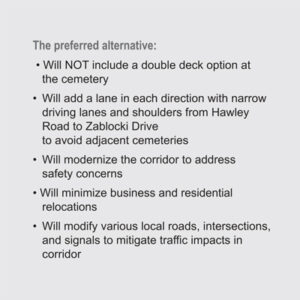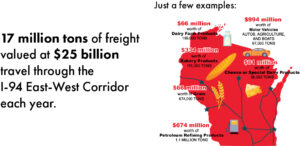FAQ
The I-94 East-West Corridor is a main artery for Wisconsin commerce. Twenty-seven percent of the jobs and 35% of the businesses in the seven-county region are within a 5-mile radius of its center. Countless others in metro Milwaukee, Waukesha County, and around the state also rely on the highway to safely transport their employees, customers, and products. However, its age and increasing deterioration create significant congestion, safety, and economic development challenges that Wisconsin must address.
According to the corridor study, reconstruction and modernization of the East-West Corridor – including rebuilding the freeway and bridges, modifying interchange access to improve safety and traffic flow, and reconstructing affected local streets would accomplish the following:
- Maintain a critical link in the local, state, and national transportation network.
- Address the obsolete design of the corridor to improve safety and decrease crashes.
- Replace deteriorating pavement.
- Accommodate existing and future traffic volumes at an acceptable level of service.
The Wisconsin Department of Transportation (WisDOT) estimates the project will require up to 3.8 million hours of on-site labor by skilled construction professionals. The wages earned on the project will flow throughout the economy, supporting local businesses. Furthermore, the National Association of Minority Contractors, Wisconsin Chapter anticipates this project will deliver up to $115 million in contracts to small, minority, and women-owned businesses through WisDOT’s Disadvantaged Business Enterprise (DBE) program. Moreover, the corridor’s improvement enhances economic competitiveness and development for decades by providing safe, efficient access to jobs, services, materials, and markets.
The East-West is a vital commerce corridor carrying nearly $25 billion in freight annually. Modernizing the roadway will help Wisconsin businesses get products like beer, motorcycles, steel, frozen pizzas, and more to market faster.
The Wisconsin Department of Transportation (WisDOT) estimated the cost to be $1.74 billion (year of expenditure $). More than ninety percent of this cost is related to pavement and bridge replacement, design, and safety improvements. Only three to six percent is due to the additional lane.
Funding for this project is not transferrable to other transportation programs like public transportation or local roads.
 The Wisconsin Department of Transportation (WisDOT) looked closely at the resurfacing option and had this to say: “In general, each highway resurfacing has a shorter life span than the previous resurfacing because the original pavement, still in place after 50 years, provides a less effective base as the concrete continues to crack and deteriorate…Based on WisDOT’s experience with other highways, resurfacing the study area freeway system again would not be cost effective.”
The Wisconsin Department of Transportation (WisDOT) looked closely at the resurfacing option and had this to say: “In general, each highway resurfacing has a shorter life span than the previous resurfacing because the original pavement, still in place after 50 years, provides a less effective base as the concrete continues to crack and deteriorate…Based on WisDOT’s experience with other highways, resurfacing the study area freeway system again would not be cost effective.”
The East-West Corridor has been resurfaced numerous times over its 50-plus-year life, most recently in 2011-12. But at this point, it’s a Band-Aid approach that would do nothing to solve the underlying safety, capacity, and traffic-handling problems.
The freeway and transit projects are complementary, and both are important to increasing safety, reducing congestion, and promoting economic development in the region.
Transit is a critical component of an effective regional transportation system – it’s just not an “either-or” proposition. The Southeastern Wisconsin Regional Planning Commission (SEWRPC) has determined that even if transit offerings doubled, it would not be enough to address traffic congestion on the East-West Corridor effectively. The solution is a robust transit element with required capacity and safety improvements to the freeway.
While the corridor is a critical link between Milwaukee and Waukesha counties, well over half of freeway traffic between 16th and 70th streets enters or leaves the freeway within the congested 3.5-mile segment. That includes veterans and military personnel heading to the VA hospital, workers at some of the area’s largest employers, fans heading to American Family Field and other attractions, and more.
Additionally, the Southeastern Wisconsin Regional Planning Commission’s (SEWRPC) Vision 2050 noted that the planned expansion of Southeast Wisconsin freeways would directly serve areas of minority and low-income populations. As a result, minority and low-income populations residing adjacent to the modernized I-94 East-West Corridor would benefit from the expected improvement in accessibility to employment. Based on 2012 project data, about 81 percent of all workers and 79 percent of the minority population in the I-94 East-West Corridor drive alone or carpool to work.
Communities in and around the area will benefit from a neighborhood-sensitive design that avoids nearby homes, businesses, and cemeteries and fewer traffic diversions onto their local streets as travelers choose the improved I-94 for their trips.
 The Wisconsin Department of Transportation (WisDOT) and the Federal Highway Administration (FHWA) engaged in an extensive and diligent process to analyze and evaluate several project design options. The process involved many public comment opportunities, including public involvement meetings, public hearings, individual stakeholder meetings, a public comment period, and frequent communication through e-newsletters.
The Wisconsin Department of Transportation (WisDOT) and the Federal Highway Administration (FHWA) engaged in an extensive and diligent process to analyze and evaluate several project design options. The process involved many public comment opportunities, including public involvement meetings, public hearings, individual stakeholder meetings, a public comment period, and frequent communication through e-newsletters.
As a result of this process, the agencies identified a preferred alternative (PA) that cuts well over $200 million off total project cost and includes essential safety and efficiency upgrades. The PA also has a neighborhood-sensitive design that avoids nearby homes, businesses, cemeteries, and the national historic landmark associated with the Clement J. Zablocki VA Medical Center.
I-94 East-West reconstruction is essential to the completion and success of the state’s $2.4 billion investment in the Zoo and Marquette interchanges. Without the East-West Corridor project, neither interchange will operate at its intended efficiency level. That diminishes the economic benefits of improved mobility, crash reductions (reconstructed Southeast Freeway System segments have had crash reductions ranging from 29% to 48%), and improved travel times.
The costs of delay are significant:
- Even with a two-year delay, project costs will grow by millions, with estimates indicating an increased project budget of $44-$60 million due to inflation alone.
- Wisconsin wastes the benefits of the upgrades in the Marquette Interchange and the Zoo Interchange if the 3.5-mile connection is a crumbling and unsafe freeway. These modern interchanges will only work as intended if the primary freeway connecting them is equally efficient and safe.
- Delay hurts the economic development of Milwaukee and Waukesha counties and impairs the region’s growth efforts. A good transportation network is key to economic growth and job creation and consistently ranks as a top criterion among business executives determining desirable commercial investment locations.
- Freeway congestion and unsafe conditions will continue to hamper travel for the one million veterans, military patients, and volunteers annually who rely on the highway for access to the Clement J. Zablocki VA Medical Center. Additionally, the VA’s cooperative arrangement with the Milwaukee Regional Medical Center north of the Zoo Interchange requires frequent emergency, patient, and employee travel between the facilities.
- Communities and neighborhoods in and around the area will continue to suffer additional traffic diversions onto their local streets as travelers avoid I-94 for more and more hours each day.

